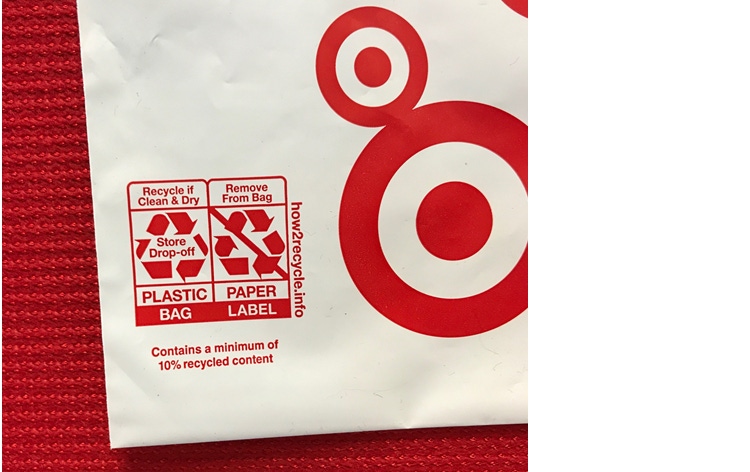The importance of accurate end-of-life labeling
August 13, 2018

Here’s an introduction to what everyone in the packaging industry needs to know about on-pack sustainability messaging.
We count on product packages to communicate a lot. From nutrition facts to product information, certifications to safety instructions, key branding to eye-catching graphics—packages have a lot to say. With all of this noise, when it comes to end-of-life labeling for recyclability, compostability or other recovery methods, it can be tempting to just place some chasing arrows in a corner and call it a day.
But to do so is not only oversimplifying a complex and nuanced topic, it is also potentially misleading to consumers, and could even put your company at legal risk. While it may seem like communication about the end-of-life for particular package is simple “green marketing,” it is much more than that, and it’s important to ensure that any such labeling is comprehensive and accurate.
What's at stake
Consumers look to the brands they trust to put relevant information on product packaging. If they learn that a particular claim is inaccurate, this can cause consumers to lose trust in the brand. In a time when consumers have what seems to be endless access to different products to meet their needs, trust is critical for maintaining brand loyalty.
Not only is maintaining consumer trust an important reason to make sure that you have accurate end-of-life labeling on your packaging, but you could also be putting your company at legal risk if the labeling is misleading or inaccurate.
The Federal Trade Commission’s Guides for the Use of Environmental Marketing Claims (or “Green Guides”) states that a package cannot be called recyclable if the majority of consumers in the U.S. cannot recycle it and “it can be collected, separated, or otherwise recovered from the waste stream through an established recycling program for reuse or use in manufacturing or assembling another item.” To put an unqualified recycling claim on a package that does not meet these criteria could constitute a violation of the FTC’s guidelines.
Even though there may be risk associated with inaccurate claims, we also know that there is high reward for accurate recycling and composting claims to help get those products and packages recovered and contribute to the circular economy. Recycling rates in the U.S. could be better, and there’s evidence to suggest that seeing a recycling claim on package helps to clear up confusion about what consumers should do with recyclable items and spur that final recycling behavior. Similarly, collecting compostable packaging can also help to capture food waste that would otherwise go to landfill, and so turn this food waste into usable compost.
Recyclable claims
Recycling is sometimes thought of as the “gateway drug” to sustainable behavior change. The idea is that recycling is so easy, it’s a great baby step for consumers looking to enact green habits. And recyclable packaging can be low-hanging fruit for companies looking to set sustainability goals.
However, the recycling system—and, consequently, the recyclability of different types of packaging—are both much more complex than many people, including some in industry, realize.
If you work in packaging, you’re almost definitely familiar with the Resin Identification Codes (RICs), or the chasing arrows surrounding a certain number that denotes the resin of a particular plastic. Many people mistakenly refer to these as the “recycling numbers,” including some working in packaging and sustainability. Some communities still use these RICs to communicate what types of plastic they will accept for recycling. However, using a RIC on its own is not enough to communicate the recyclability of the package. These codes were created for use by industry insiders to help differentiate between the different kinds of plastic resins that were being developed, and they were never actually intended to communicate recyclability.
The codes don’t tell the full story of a package’s recyclability, and using one of these codes alone is misleading for consumers who may not know that just because something has a certain number does not necessarily mean it’s recyclable.
During the development of the How2Recycle label, which was designed to provide clear, concise recycling instructions for all packaging types, consumer research found that many consumers were confused by RICs and often had no idea what they meant: some thought that the numbers referred to the most popular type of plastics, while others thought it was an indication of the number of times the material had already been recycled.
If you have to use a RIC on a package, be sure to update to the more accurate and recently released equilateral triangle version of the code that does not use the chasing arrow symbol associated with recycling and recyclability.
When you consider the recyclability of a certain package, it’s important to think about several factors, including: Do consumers have access to recycle this package? Will this package sort correctly in a material recovery facility (MRF)? Will this package have any issues with reprocessing? And finally, are there end markets in existence willing to buy the final recycled material made from this packaging? Even if the material of a package is technically recyclable, there can still be something about the package’s attributes or how it all fits together that impacts its recyclability and ability to make it through the recycling system.
It’s possible that there are only certain components of a package that are recyclable, while others need to be disposed of before the rest of the package can be recycled. For example, plastic bottles with pumps that have metal springs inside of them need to have the pump removed before recycling, because the metal spring is a contaminant in the plastic recycling stream.
If the consumer needs to take some kind of action before recycling a package, or if only part of the package is recyclable, then this should clearly be communicated on the packaging along with any recyclability claims, so that the consumer is not misled into unintentionally contaminating the recycling stream. Once you have determined the recyclability of your package, it’s important to give consumers clear, concise recycling instructions.
Biodegradable and compostable claims, a primer
Perhaps your packaging isn’t recyclable, but instead you want to put language on the package that says it’s biodegradable or compostable. If you do so, make sure to keep in mind the key differences between these attributes, as many consumers don’t know the difference and are liable to get confused and potentially frustrated.
When considering adding biodegradability additives to your plastic packaging, you may want to consider that making your packaging “biodegradable” through the use of additives may not be as sustainable as you think. The Sustainable Packaging Coalition (SPC) has an official stance against the use of biodegradability additives in conventional plastics.
With both biodegradable and compostable packages and products, be careful that the on-package language does not imply that the product or package is litter-friendly. A study conducted by Keep America Beautiful found that people are most likely to litter an item when they believe that item is biodegradable. Even most compostable products and packaging are only designed to compost in an industrial composting setting, and it’s important to make sure that the claims on package don’t imply to the consumer that if they throw the package out into the environment that it will simply “go away.”
Many consumers don’t realize that most compostable products and packaging are not designed to decompose in their home compost piles. There are different kinds of certifications for compostability, so be sure to communicate which of the certifications your package or product has received. If the item can only be composted in an industrial composting facility, such facilities may not exist where all consumers live, so this disclaimer should be included.
There are also some state laws that require compostable plastic to be labeled as not recyclable, to ensure that consumers don’t unintentionally contaminate the recycling stream by trying to recycle them.
It’s misleading to state that a certain percentage of the package is compostable while not clarifying whether or not a component needs to be removed before composting, or whether the consumer actually cannot separate the non-compostable components from the rest of the package. If the package says that it’s 80% compostable because 80% of the package is paper but the other 20% is a polyethylene lining, then the whole package is not compostable. There’s no way for the consumer to remove the lining from the paper, and if they put that package in a composting facility, even if the paper breaks down, the lining will remain and will contaminate the final compost product.
The big picture
With all of these considerations, it might seem easiest to skip out on end-of-life labeling entirely. But consumers not only appreciate the transparency of end-of-life labeling, they are increasingly demanding it.
Responses to the How2Recycle program’s Consumer Survey indicate that one of the main reasons consumers have a more positive impression of a company after seeing the How2Recycle label on one of their packages is because of the increased transparency, even in cases where the company used a label indicating the package is not recyclable. Even when packages cannot be recovered through recycling or composting, consumers want to know. It increases their trust in a brand that tells them the whole story, and opens up opportunities for brands to communicate to consumers what they might be doing to improve the end-of-life story for their packaging.
In this era of increased scrutiny, make sure that the end-of-life claims on your package aren’t fake news.

Jessica Edington joined GreenBlue in May 2017 as a project associate for the Sustainable Packaging Coalition’s How2Recycle program. Previously, she worked as a consultant for Green Strategies in Washington, DC, where she assisted corporate clients with developing strategies to engage consumers, business partners and other stakeholders in improving the environmental impact of their products and services. Edington also has experience in environmental education and sustainable agriculture, and worked on a residential solar campaign in the Hudson Valley. Her dual passions are writing and the environment, and she received her B.A. in English with a minor in Environmental Science and Policy from the College of William & Mary.
********************************************************************************
Packaging solutions come to Minneapolis: As part of the region’s largest advanced design and manufacturing event, MinnPack 2018—and the five related shows taking place alongside it—brings 500+ suppliers, 5,000+ peers and 60+ hours of education together under one roof. Register for free today.
About the Author(s)
You May Also Like


